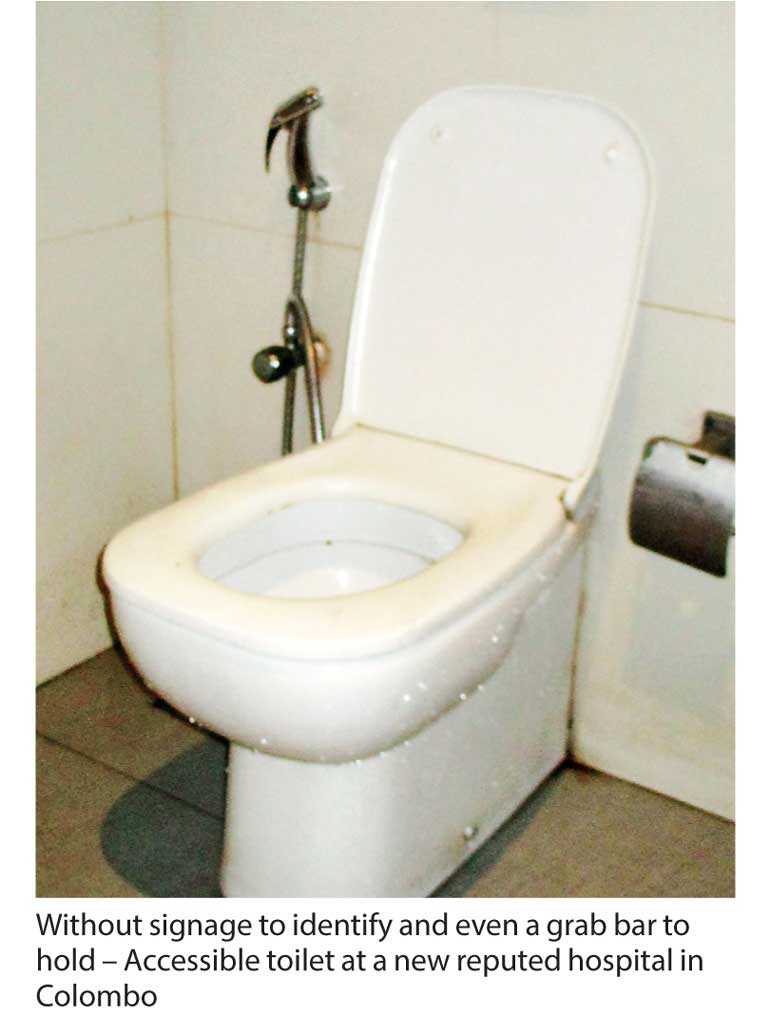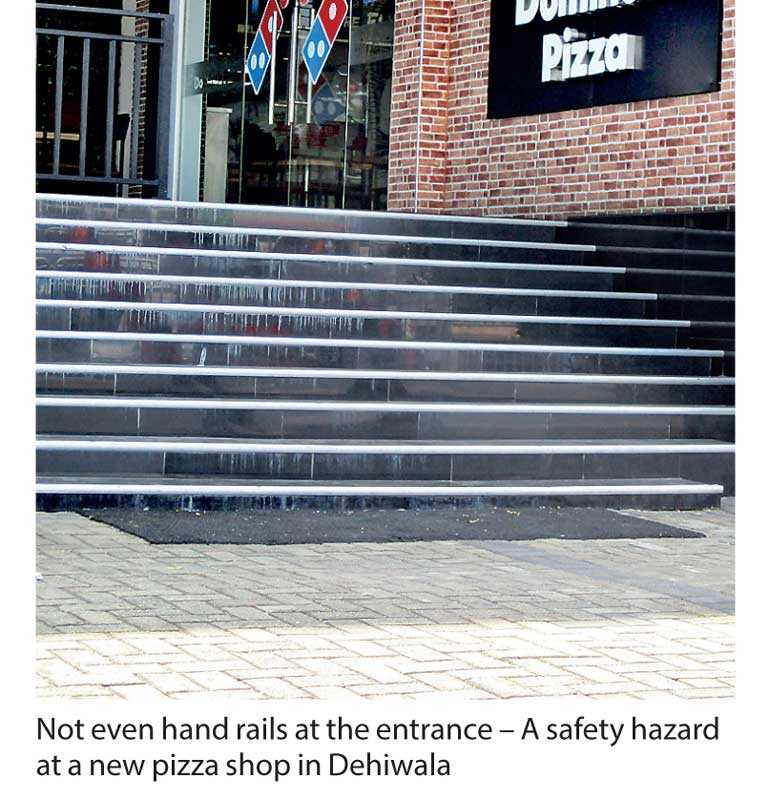Sunday Mar 09, 2025
Sunday Mar 09, 2025
Wednesday, 26 September 2018 00:00 - - {{hitsCtrl.values.hits}}
Have you not yet realised that the chances are now very high that at any stage or any moment in life, for a short time or for a long time, for different reasons, you or your loved ones could experience physical and/or sensory impediments, and fall into the category of ‘People with Disabilities’ as defined by the law?
You will then realise that the world around you once you knew to be cheerful and kind is no more so and most of your essential needs and activities that were easy doing are now a burden and you are unwantedly depending on others.
At this very moment, an estimated 20% of fellow citizens (i.e. four million) are in this plight; and you would soon be merely one of such affected persons.
The design of your home, office, places of recreation, shops, banks and restaurants, stairs, toilets, doorways and ramps, ATMs, the web or phones could no longer be easily used.
The world around would marginalise you and discriminate against you beyond expectations, perhaps for lifetime. As fate is no respecter of persons and positions, tomorrow will be too late for you and your loved ones.
As such, quality of our own life depends heavily on buildings and environment we build. Are they accommodating, safe and user-friendly? They are yet not built so!
That is why you cannot wait ineptly but must fight now for equality of treatment to enjoy your civil rights and bring constant pressure on decision makers.
Impediments in real world
Any person, who, as a result of any deficiency in his physical or sensory or mental capabilities, if unable by himself to ensure for himself, wholly or partly, the necessities of daily life, is recognised by law, as a person with dis-ability or a dis-abled – (differently able is a false injurious terminology).
The affected include senior citizens (heading towards 18%), those fallen by accidents and numerous debilitating medical conditions and the convalescent, and even the pregnant experiencing restricted movements.
Public buildings and public facilities means any building or facility, owned either by the State or private sector that the public needs to use in daily life, as categorised and listed under the existing Laws.
Legislations gathering cobwebs
Sri Lanka enacted the Protection of the Rights of Persons with Disabilities Act No. 28 of 1996. Clause 23(2) of this Act stipulates: “No person on the ground of disability, be subjected to any liability or restriction with regard to access to or use of any building or place which any other member of the public has access to or is entitled to use.”
What meaningful progress have we made in this regard after 22 long years?

Under Clause 23(2) of this ACT, by Gazette No. 1,4657/15 dated 17 October 2006, the Ministry of Social Services promulgated a very comprehensive detailed set of Regulations clearly stipulating design and space requirements and safety measures to be adopted in the construction of new buildings that are listed.
These regulations were then approved unanimously by our Parliament on 20 March 2007.
Despite three extensions of the deadline by the Social Services Ministry and a comprehensive Circular dated 4 October 2012 under reference MSSS/7/8/ACC to all ministries by the secretary to the Ministry of Social Services, compliance with these Regulations has still not been achieved even after 12 years.
A proliferation of buildings, facilities and places, especially in the megapolis area, are being completed either new or after major renovations.
Yet, key parts and facilities, especially toilets and wash facilities, steps and railings, signage, ramps and entrances, fail to comply with specifications and requirements stipulated by the laws.
The buildings and places recognised by the existing laws and are concerned here include hospitals, hotels and restaurants, places of education and higher education, supermarkets and shopping complexes, ATM Machines, sports stadia including at international venues and a large number of office buildings including those belonging to ministries and chief ministers.
It’s now or never!
In recognising the resulting colossal losses that affect a wide range of people, this writer invoked the Fundamental Rights jurisdiction of the Supreme Court in 2009.
The order given by this Apex Court on 27 April 2011 indicates: compliance with it is mandatory for all buildings and parts as identified by the accessibility regulations, and constructed new, requiring authorities to issue certificate of conformity.
Yet, the regulatory authorities since 2011 April have continuously failed to ensure compliance before issuing certificate-of conformity.
Construction companies obtain certificates of conformity in the absence of due compliance well.
Compliance with design specifications that take into consideration human safety is a low cost and feasible indispensable investment bringing rich dividends to everyone in society. Embracing diversity is a win-win situation of business.
The colossal waste and the threat to safety and human life caused by the failure to comply with Regulations and Court orders is huge compared to the money needed.
In a jail in own country?
Safely accessible and useable built environments are essential for the dis-abled people to integrate to the community and advocate their rights.
It is crucial to arrest soon this vicious circle of non-compliance – it is now or never! If not, what is sure to result?
Poor access to buildings that are essential in daily life, to education, to social and recreational facilities, no access to public transportation, poor access to the job facilities, loss of earning chances causing increasing unwanted dependency, poverty and segregation will also continue rampantly.
The Government of Sri Lanka has embarked on an ambitious plan of development, specifically within the Western Province, which would result in a very significant number of new buildings and places – the types that are indicated in Regulations – the public will need to access and use in daily life, being constructed at rapid pace.
This development is long-term projects and are inextricably entwined with the future of the next several generations of Sri Lankans.
With such adverse trend prolonging, we reasonably fear that if such mega-development projects are not regulated adequately without further delay the next generation of persons suffering from inevitable mobility impediments – numbers of whom will be much larger than at present – will be prevented from freely accessing and using the facilities there in at a wide range of new buildings and enjoying this next phase of development of Sri Lanka.
Back-peddling of the UN Convention (CRPD)
Based on a proposal made by the Social Services Minster, which was then unanimously approved by the Cabinet of Ministers, on 8 February 2016 the Government of Sri Lanka ratified the International Convention on the Rights of Persons with Disabilities (UNCRPD).
Promises were then given of State recognition to the ability and contributions made by the dis-abled people (Article 8), meaningful realisation of Article 12.1 of our own Constitution for citizens with disabilities – right to equality.
Thirty months have passed but nothing yet has resulted – even to meaningfully explore ways and means of expediting implementation!
UN CRPD is a legally binding agreement with comprehensive protection of the rights of persons with disabilities, which requires a commitment by each ratifying State for its implementation.
UNCRPD states clearly, the ratifying states should not discriminate against persons with disabilities and sets out with greater clarity the obligations on states indicating the steps that must be taken, to promote, protect and ensure enjoying their rights, especially enabling environments so that dis-abled persons start enjoying meaningful real equality in society.
For example, the Convention requires states to take measures to ensure accessibility of the physical environment and information and communications technology, prohibit discrimination and achieve equality for all.
The international community, the UN in particular, who are much concerned about several other rights in this part of the world, in their actions, regretfully, appears to have overlooked the world’s largest minority – the people with dis-abilities - and allow countries such as Sri Lanka to remain stuck at CRPD’s birth itself for so long, as 30 months, without promoting actively to start them even crawling in the right direction.
We wonder for how long the custodians of CRPD, the United Nations would allow a State after its ratification, to keep prolonging implementation, even without making a genuine start with easy-to-implement clauses that does not require any new legislations or added costs, such as Articles 8 and 9.
Prolonging will set a bad example to the other nations.
A committed deadline for full enforcement, enabling the dis-abled to start enjoying their enshrined rights – the ultimate long awaited end-result – is a prerequisite.
If there is a commitment that is sincere to ensure Sri Lanka’s largest minority will enjoy the desired results – as some nations have done to expedite matters and deliver the results without further delay – why cannot we present the CRPD as it is to the Parliament and get its approval, and thereby enable implementation to be legally binding?
Remember, a genuine effort here with a vision to move ahead on fast track would also afford a low-cost feasible fine opportunity to enhance Sri Lanka’s human rights image.
(The writer, a paraplegic since 1992, qualified academically and professionally, has gained national recognition and won international admiration in both cricket and chemistry. Personal adversity has turned this former Senior Manager in industry into a pioneer accessibility rights activist and a competent advisor on accessibility. See: goo.gl/tZZsmz.)
Discover Kapruka, the leading online shopping platform in Sri Lanka, where you can conveniently send Gifts and Flowers to your loved ones for any event including Valentine ’s Day. Explore a wide range of popular Shopping Categories on Kapruka, including Toys, Groceries, Electronics, Birthday Cakes, Fruits, Chocolates, Flower Bouquets, Clothing, Watches, Lingerie, Gift Sets and Jewellery. Also if you’re interested in selling with Kapruka, Partner Central by Kapruka is the best solution to start with. Moreover, through Kapruka Global Shop, you can also enjoy the convenience of purchasing products from renowned platforms like Amazon and eBay and have them delivered to Sri Lanka.
Discover Kapruka, the leading online shopping platform in Sri Lanka, where you can conveniently send Gifts and Flowers to your loved ones for any event including Valentine ’s Day. Explore a wide range of popular Shopping Categories on Kapruka, including Toys, Groceries, Electronics, Birthday Cakes, Fruits, Chocolates, Flower Bouquets, Clothing, Watches, Lingerie, Gift Sets and Jewellery. Also if you’re interested in selling with Kapruka, Partner Central by Kapruka is the best solution to start with. Moreover, through Kapruka Global Shop, you can also enjoy the convenience of purchasing products from renowned platforms like Amazon and eBay and have them delivered to Sri Lanka.